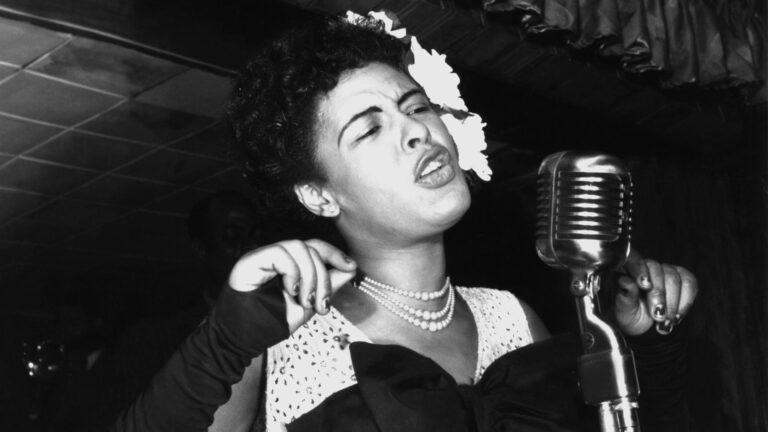The haunting lyrics of “Strange Fruit” paint a picture of a rural America where political and psychological terror reigns over African-American communities.
“Black bodies swinging in the South breeze,” sang blues legend Billie Holiday in her powerful 1939 recording of the song “Strange fruit hanging from the poplars.” The song’s lyrics describe the daily violence inflicted on black people. And Holiday dared to play it, in front of a black and white audience.
“She wanted to make a statement with this song. There was something about standing in front of a white audience and being brave enough to confront the continuing criminality in the United States,” says Karsonya (Kaye) Wise Whitehead, associate professor of African and African American studies. at Loyola University Maryland. “The writing wasn’t just about the past: it was happening in that moment.”
“Strange Fruit” began as a poem
More than 4,000 black people were publicly murdered in the United States between 1877 and 1950, according to the Equal Justice Initiative’s 2015 report, Lynching in America. “Strange Fruit” was written during a decade when activist organizations such as the National Association for the Advancement of Colored People were lobbying lawmakers to make lynching a federal crime. But the NAACP’s efforts were continually reversed by white supremacists in the Democratic Party who have used the filibuster to defeat such bills.
Abel Meeropol, an American Jew whose family had fled pogroms in Tsarist Russia, wrote “Bitter Fruit” as a reflection in the August 7, 1930 photo of lynchings of J. Thomas Shipp and Abraham S. Smith in Marion, Indiana. Shipp, 18, Smith, 19, and James Cameron, 16, were charged with robbery, murder and rape. Cameron managed to escape the mob, but Shipp and Smith were dragged from their cells and beaten to death. The photo shows the bodies of Shipp and Smith hanging from nooses as a crowd of white people watch their bodies. A man looks towards the camera while showing the atrocity.
Under the pseudonym Lewis Allan, Meeropol set his poem to music and performed “Bitter Fruit” as a protest song in the New York area alongside his wife Anne. They even performed it at Madison Square Garden with blues singer Laura Duncan. The song, now known as “Strange Fruit,” was introduced to Billie Holiday in late 1938, just as she had booked a series of shows at Barney Josephson’s Café Society, New York’s first racially integrated nightclub. York.
Billie Holiday performing at Club Downbeat in Manhattan, c. 1947.
Holiday’s performance left the audience silent
After overcoming her reluctance to tackle it, Holiday made “Strange Fruit” her signature song. As his shift came to an end, the waiters stopped serving. Then, Holiday would sit alone on a stool with only the microphone and a pin in her face while she sang. After the last lines: “Here is a fruit that the crows can pluck/For the rain to gather/For the wind to suck/For the sun to rot/For the tree to fall/Here is a strange and bitter harvest” – A cold silence often followed and Holiday left the stage.
“When the lights came back on, she would be gone, there would be no encore,” Whitehead says. “She would leave the stage – that was her request – but she just wanted to leave the song hanging. And that would be his last statement. And they often talk about how white audiences would be uncomfortable clapping.
Whitehead, who is also founding director of the The Karson Institute for Race, Peace, and Social Justice adds: “We often think of Billie Holiday as a singer. And we think of black women in this era as just great singers, but I don’t think we talk enough about them using their platform to take a stand against injustice and then the cost and the price that they paid for that.
A Time The magazine’s reviewer witnessed Holiday’s performance and wrote a column about it, featuring photos of Billie Holiday as well as the song’s lyrics. “When Billie appeared in Timeit gave him such prestige,” recalls Barney Josephson in his book Café Society: the wrong place for the right people. “It made Billie a black artist who had something to say and who said it, who had the courage to say it, to sing it.”
“Strange Fruit” named song of the century
Holiday may not have predicted the impact on her Time a magazine review would have, but she understood the power of the song. Holiday’s vocalization and improvisation skills gave Meeropol’s poetry strength and emotional impact.
“The first time I sang it I thought it was a mistake and I was right to be afraid,” Holiday wrote in her autobiography. Lady sings the blues. “There wasn’t even a thunderous applause when I finished. Then a lone person started clapping nervously. Then suddenly everyone applauded.
Holiday then recorded “Strange Fruit” with the Commodore’s Records jazz label on April 20, 1939. The song helped elevate Holiday to national prominence, at just 23 years old.
Not all audiences appreciated Holiday’s performance of the song. Among them was the director of the Federal Bureau of Narcotics, Harry Anslinger. Anslinger, who openly adheres to racist viewsensured that Holiday, who struggled with drug use, was targeted, prosecuted and stopped in 1947 for drug possession. She was sent to the Alderson federal prison camp in West Virginia for a year. Upon his release, Holiday was barred from obtaining a cabaret entertainer’s license.
Despite her struggles, Holiday’s performance of “Strange Fruit” continued to resonate – and it remains among her best-selling recordings. In 1999, Time review version named Holiday of “Strange Fruit”, the “song of the century”.


